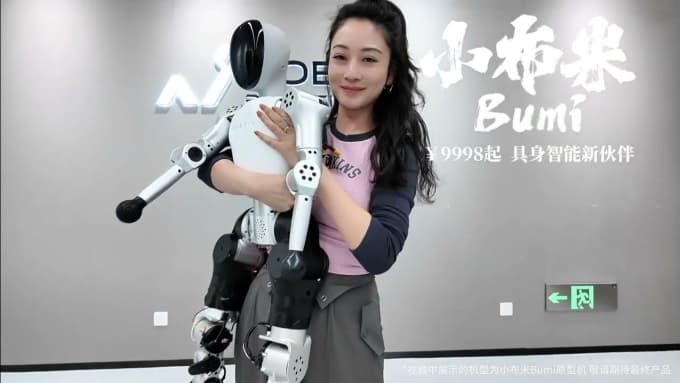A new price point for humanoids
Chinese robotics startup Noetix has introduced Bumi, a 94 centimeter tall, 12 kilogram humanoid robot priced at 9,998 yuan, roughly 1,380 dollars. The launch puts a child sized bipedal machine near the price of a premium smartphone in China, a threshold that recently still sounded out of reach for consumer robots. Early demand arrived quickly, with more than 100 units sold in the first hour and the first 500 booked within two days on JD.com, according to the company.
Bumi is not pitched as a heavy lifter. It is built for education and family entertainment. The robot walks on two legs, responds to voice, can dance, and invites coding through simple visual tools. The package integrates with JD.coms Joy Inside 2.0 ecosystem and supports open programming interfaces so teachers, students, and makers can script behaviors and experiment with movement and perception. For a category that often costs tens of thousands of dollars, Bumi sets a fresh reference point for what a consumer grade humanoid can cost.
How Noetix cut the price
Noetix says it hit the sub smartphone price by redesigning the product stack from the circuit board level to the production line. The team organized its approach around three pillars: vertical integration, structural rework that cuts mass, and a domestic supply chain that shortens lead times and trims logistics costs. Each element trims expense on its own. Combined, they produced cascading savings, since lighter parts allow smaller motors and batteries, and in house electronics avoid supplier markups while aligning software and hardware.
Vertical integration
Noetix designs and builds control boards and motor drivers internally instead of buying off the shelf modules. That removes layers of supplier margin and lets the engineering team tune motion control, sensing, and power management as a single system. When one team owns the firmware, motor driver, and control loop, performance targets can be met with simpler parts because the software can be matched to the hardware rather than over specifying components for safety margin. This creates cost benefits without blunt compromises on responsiveness or stability.
Structural rework
Bumi uses composite materials for most of the frame, adding metal only where loads demand it. Weight is brought down to 12 kilograms. In robotics, mass drives motor torque and battery capacity. A lighter chassis lets engineers choose smaller actuators, gear trains, and cells, which then reduce cost and complexity again. It also helps with balance control, since there is less inertia to arrest during gait transitions. Careful reinforcement at joints provides the stiffness needed for precise placement without carrying the expense of all metal construction.
Localized supply chain
Nearly all parts for Bumi are sourced inside China, including motors, sensors, and Rockchip processors. That choice leverages a dense manufacturing base that can provide quick iteration cycles, short delivery routes, and competitive pricing. When suppliers, sub assembly partners, and final assembly plants sit in the same regions, logistics risks and inventory buffers can be reduced. It also makes engineering change orders faster to implement, which helps a young company refine a first consumer product without tying up capital in slow moving stock.
The result is a compact humanoid with a bill of materials and assembly flow fitted to mass production rather than a lab prototype. Noetix positions Bumi as a consumer product first, and an accessible platform for learning and development.
What Bumi can do today
Bumi stands 94 centimeters tall, weighs about 12 kilograms, and moves with 21 or so joints across its limbs and trunk. It walks, balances, and performs coordinated movements like short runs and dance routines. The robot is powered by a 48 volt battery with a capacity a little over 3.5 ampere hours, which translates to about one to two hours of mixed use per charge depending on speed, movement intensity, and onboard computation load.
Interaction is designed to be simple. Cameras in the head help Bumi recognize a scene and the people in it. Voice interaction and app controls handle commands. For classrooms, Bumi supports drag and drop graphical programming that lets students build behaviors without writing code from scratch. More advanced users can call open interfaces to extend capabilities and integrate with other devices or services. Integration with JD.coms Joy Inside 2.0 ecosystem is meant to give Bumi access to content and third party features that can be delivered and updated over time.
Public demos so far show Bumi walking across short distances, turning, recovering balance, and performing choreography. Those clips align with its stated role as a social companion and a learning tool, not as a shop floor worker.
Who Bumi is for and what it is not
Noetix built Bumi for spaces where people gather, not for factories or warehouses. The 94 centimeter form factor was chosen to fit living rooms and classrooms and to feel less intimidating around children. The size and weight also reduce the risk of impact injuries, which matters for a robot that will spend time close to students. The design aims to limit pinch points and hard edges while still offering a wide range of motion.
Bumi is not intended to lift heavy items, climb ladders, or handle hazardous materials. Its duty cycle and battery pack suit short learning sessions, guided activities, and family entertainment. That follows the pattern of consumer robotics, where platforms find traction first as companions and creative tools before moving toward more capable household assistance.
Noetix also references the concept of the uncanny valley, the uncomfortable feeling people can have when a robot looks almost human but not quite. A smaller, clearly robot like form and exaggerated motions tend to reduce that reaction, which can make interaction friendlier for children learning with a machine for the first time.
Factories, funding, and scale
Noetix closed a nearly 300 million yuan pre B financing round led by Vertex Ventures. The capital supports factory expansion and supplier tooling so the company can move from early presales to volume production. The company says its Beijing facility can deliver more than 200 units per month. A new plant in Changzhou in Jiangsu province is expected to reach about 300 units per month by December. A third site is under planning that could add another 500 units per month. The goal is an output of roughly 1,000 units each month by late 2025.
Early orders provide a demand signal, but margins remain thin while the company ramps. At a media briefing in Beijing, Noetix founder Jiang Zheyuan acknowledged the near term economics directly. He also summarized the cost discipline that went into the launch price.
Profit margins are indeed quite low.
Venture funding will cover the burn as factories and suppliers settle into steady yields. The test is whether Noetix can keep quality high at this price while the software team pushes out updates that add value for owners over time.
Chinas race to consumer humanoids
China is moving fast to build affordable humanoids. Unitree introduced its R1 earlier this year at 39,999 yuan, a fraction of the price of its more advanced G1 platform. Local and municipal programs are supporting robotics training and test facilities to help companies bring designs to market quickly. Domestic chip suppliers and motor makers have benefitted from the push for home grown supply chains, which is one reason Bumi uses a Rockchip processor and Chinese actuators.
In this environment Bumi is best seen as a cost marker, a sign that a child sized biped can be built and sold at a price close to an iPhone in China. Larger Western projects point to far higher targets. Teslas Optimus has been described with a price goal near 20,000 dollars, which serves a different purpose and feature set. That does not make the products direct competitors. It shows the spread of use cases and budgets across the humanoid spectrum.
What are the trade offs
Reaching a price below 10,000 yuan invites inevitable trade offs. Runtime is one to watch. A one to two hour window suits classes and demos but may feel short in a long school day or a busy home. Bumi is light and child friendly, which helps safety, yet light frames can flex under repeated load, raising questions about long term durability. Service and repairs are another factor. A low sticker price can be undermined by hard to replace parts if fall damage or wear and tear are common. Noetix says it will scale production and logistics, and the company will need a service pipeline that is just as responsive.
Motion capability is tuned for education, not heavy tasks. That choice keeps cost down and reduces risk, but it limits what owners should expect from the robot. The developer ecosystem will take time to mature. Simple blocks based coding is welcoming. Teachers and enthusiasts will still look for robust software libraries, reproducible behaviors, and clear documentation so a class in one city can recreate a project from another. Data privacy and safety should be transparent as well, especially when cameras and microphones are in classrooms or homes.
These are common challenges for any new consumer robot. The upside for Noetix is that an accessible price broadens the user base. A larger community tends to discover what a platform is best at, which then guides updates, accessories, and course material.
Technical snapshot
The core specifications and features that define Bumi today reflect the focus on accessibility and learning. Here is a concise view of what the robot offers at launch.
- Price: 9,998 yuan in China, about 1,380 dollars.
- Dimensions and mass: approximately 94 centimeters tall, about 12 kilograms.
- Mobility: bipedal walking, balancing turns, short runs, and dance movements suited to classrooms and living rooms.
- Battery and runtime: 48 volt pack rated a little over 3.5 ampere hours, about one to two hours of use per charge depending on activity.
- Control and programming: voice interaction and app control, drag and drop graphical programming for beginners, open interfaces for developers.
- Sensing: camera based vision in the head, inertial sensing, and other onboard sensors used for balance and interaction.
- Computation: domestic processor platform using a Rockchip chip, with in house control boards and motor drivers designed by Noetix.
- Supply chain: motors, sensors, processors, and most structural materials sourced domestically to reduce cost and improve iteration speed.
- Integration: designed to work with JD.coms Joy Inside 2.0 ecosystem for content and services that can expand over time.
- Production scale: company target of roughly 1,000 units per month by late 2025 with facilities in Beijing and Changzhou and a third site planned.
- Market position: aimed at education and home entertainment, not industrial or household heavy labor.
Highlights
- Bumi is a 94 centimeter, 12 kilogram humanoid priced at 9,998 yuan, around 1,380 dollars.
- More than 100 units sold in the first hour and 500 in two days on JD.com, the company said.
- Three cost levers drove the price: in house electronics, lighter composite structure, and a domestic supply chain.
- Battery runtime is about one to two hours per charge, suited to classes and short sessions.
- Built for education and family entertainment with voice control, cameras, and simple programming tools.
- Noetix raised nearly 300 million yuan in pre B funding and is building capacity toward about 1,000 units each month by late 2025.
- China is pushing affordable humanoids, with rivals like Unitree R1 at 39,999 yuan targeting different features.
- Noetix founder Jiang Zheyuan said margins are low while production ramps, highlighting the challenge of sustainability at this price.
- Integration with JD.coms Joy Inside 2.0 ecosystem and open interfaces aim to grow a developer and educator community.




